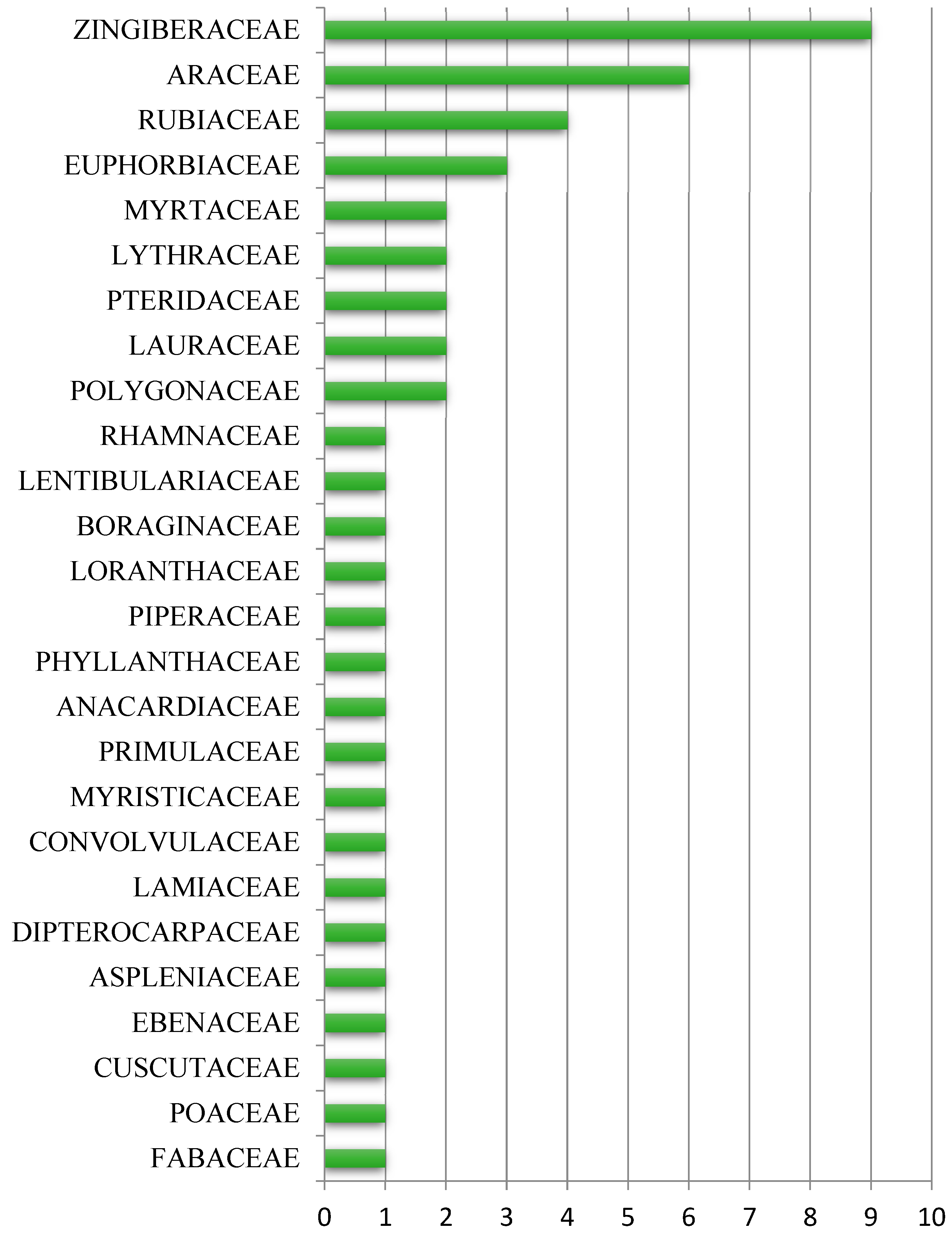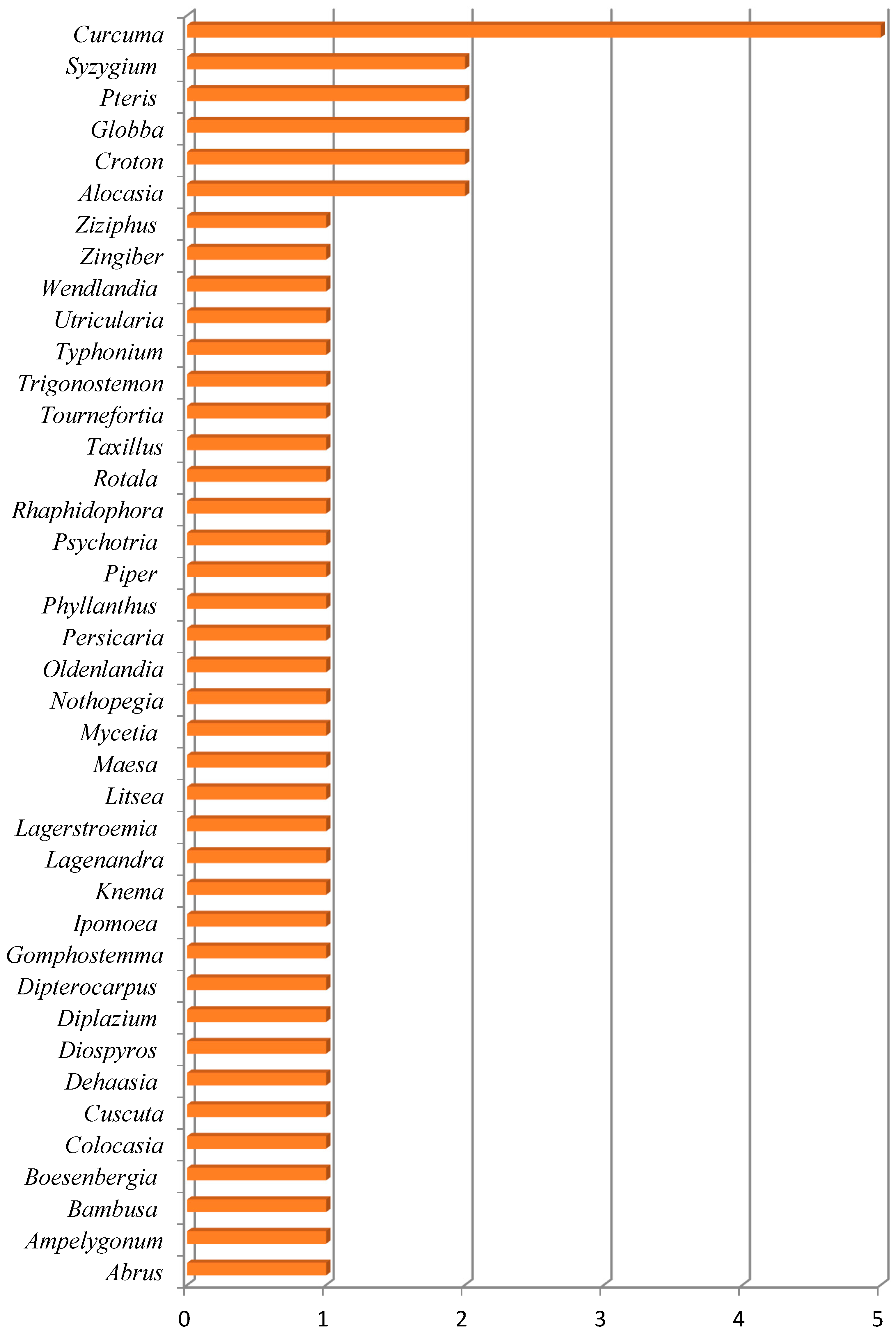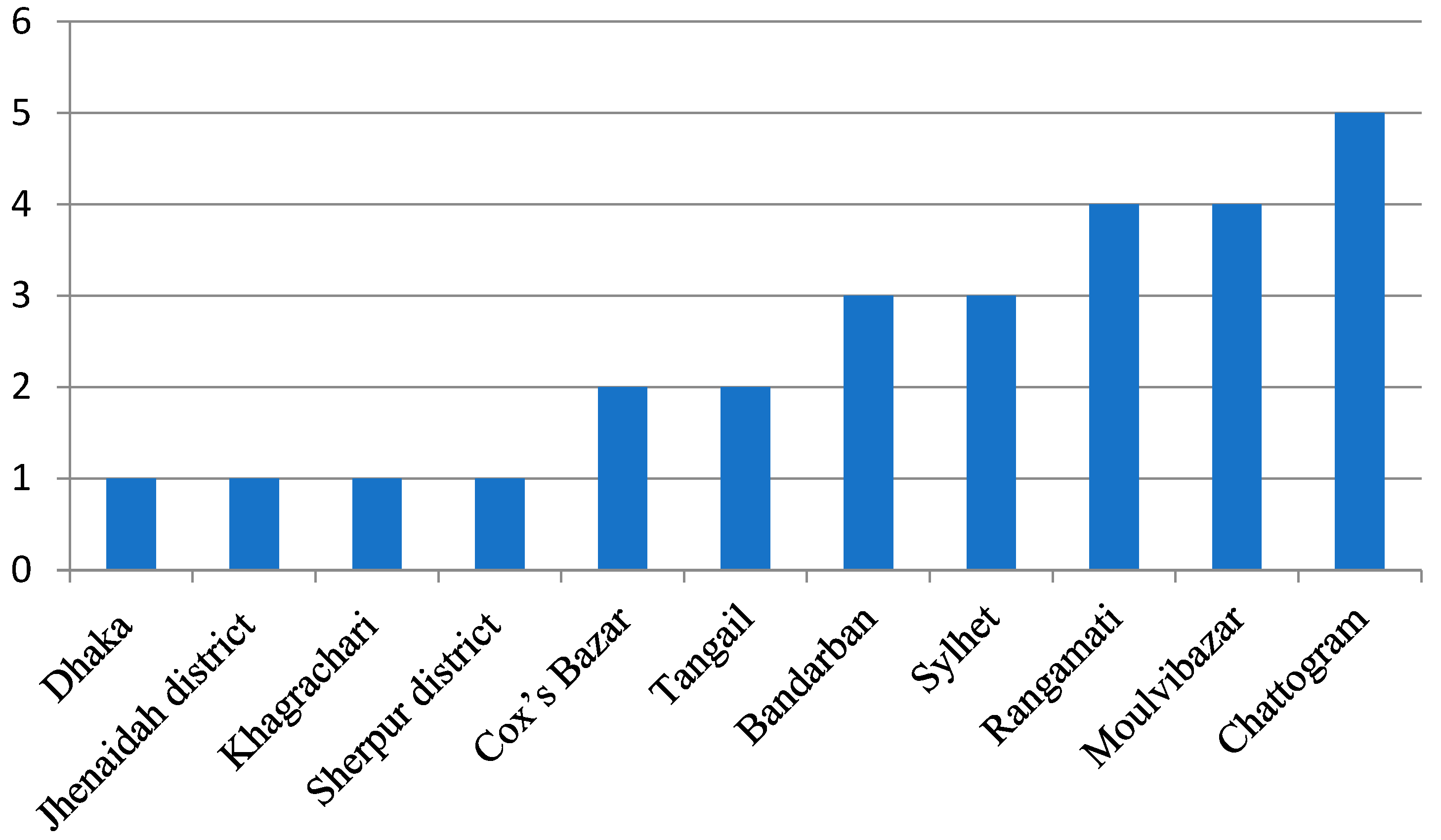Submitted:
26 November 2023
Posted:
27 November 2023
You are already at the latest version
Abstract
Keywords:
Introduction
Materials and Methods
Results and Discussion
- Abrus precatorius L. var. albo-spermum Hassan, Rahman et Afroz, Bangladesh J. Pl. Taxon. 28(2): 289 (2021). FABACEAE. Habit: Climber. Type: Bangladesh, Dhaka, Dhaka University Botanical Garden, M.A. Hassan 6001, 24 October 2021 (Holotype: DUSH) (Hassan et al., 2021).
- Alocasia hararganjensis H. Ara & M.A. Hassan, Bangladesh J. Pl. Taxon. 25(2): 228 (2018). ARACEAE. Habit: Herb. Type: Bangladesh, Moulvibazar district, Gazipur beat, Hararganj reserve forest, 21.05.2005, Hosne Ara HA 1740 (DACB). Herbarium specimens: HA 1468 (DACB); HA 2885 (DACB) (Ara & Hassan, 2018).
- Alocasia salarkhanii H. Ara & M.A. Hassan, Bangladesh J. Pl. Taxon. 25(2): 231 (2018). ARACEAE. Habit: Herb. Type: Bangladesh, Moulvibazar district, Lawachara reserve forest, 15.05.20005, Hosne Ara HA 1467 (DACB). Herbarium specimens: HA 2630 (DACB), HA 2651 (DACB) (Ara & Hassan, 2018).
- Ampelygonum salarkhanii Hassan, Bangladesh J. Bot. 20(2): 245 (1991). POLYGONACEAE. Habit: Herb. Type: Bangladesh, Bandarban, Chimbuk hill, 1990, Hassan s.n. (DACB DUSH). Herbarium specimens: Rahman et al. 7954 (HCU) (Rahman & Rashid, 2013), Anwar-0686 (Islam et al., 2016).
- Bambusa comillensis Alam, Bangladesh J. Pl. Taxon. 3(2): 41 (1996). POACEAE. Habit: Herb (Kew, 2023; POWO, 2023).
- Boesenbergia islamii Yusof & M.A.Rahman, Saudi J. Biol. Sci. 10(1): 51-55 (2003). ZINGIBERACEAE. Habit: Herb. Type: Bangladesh, Chittagong, Chunati, Near forest beat office, 02.10.1997, Yusuf & Rahman, 1019 (BCSIRH: holo., HCU: iso.). Herbarium specimen: Chittagong, Sitakunda, Chandranath hill, 31.08.2009, Rahman s.n. (HCU) (Rahman & Rashid, 2013).
- Colocasia hassanii H. Ara, Bangladesh J. Pl. Taxon. 25(1): 102 (2018). ARACEAE. Habit: Herb. Type: Bangladesh, Bandarban district, on the way to Betchari, 22.9.2004, Hosne Ara HA 1215, 1216 (DACB). Herbarium specimens: HA 1291, 1292 (DACB) (Ara, 2018).
- Croton chittagongensis Chakrab. & N.P. Balakr, Proc. Indian Acad. Sci., Pl. Sci. 92: 365 (1983). EUPHORBIACEAE. Habit: Tree. Type: Chittagong Hill Tracts, Rangamati, Mainamukh, 09-05-1939, Dent 72 (CAL) (Rahman & Rashid, 2013).
- Croton chlorocalyx Müll.Arg., Linnaea 34: 109 (1865). EUPHORBIACEAE. Habit: Shrub. (Kew, 2023; POWO, 2023).
- Curcuma bakerii Rahman & Yusuf, Plantae Discoverie 1: 21 (2012). ZINGIBERACEAE. Habit: Herb. Type: Bangladesh, Tangail, Madhupur Sal forest,14.05.1996, Rahman & Yusuf 938 (BCSIRH: holo, HCU: iso) (Rahman & Rashid, 2013).
- Curcuma hookerii Rahman & Yusuf, Plantae Discoveries 1: 23 (2012). ZINGIBERACEAE. Habit: Herb. Type: Bangladesh, Chittagong, Barakundu, 18.04.1994, Rahman & Yusuf 867 (BCSIRH: holo.; HCU: iso.). Herbarium specimens: Rahman et al. 2773, 2774 (HCU) (Rahman & Rashid, 2013).
- Curcuma roxburghii Rahman & Yusuf, Bangladesh J. Plant Taxon. 19(1): 80 (2012). ZINGIBERACEAE. Habit: Herb. Type: Bangladesh, Rangamati, Rangapani, 08.07.1993, Rahman & Yusuf 803 (BCSIRH: holo.; HCU: iso.). Herbarium specimen: Rahman et al. 3248 (HCU) (Rahman & Rashid, 2013).
- Curcuma wallichii Rahman & Yusuf, Bangladesh J. Plant Taxon.19(1): 82 (2012). ZINGIBERACEAE. Habit: Herb. Type: Bangladesh, Moulvi Bazar, Srimangal, Lawachara forest, 16.07.1993, Rahman & Yusuf 813 (BCSIRH, HCU) (Rahman & Rashid, 2013).
- Curcuma wilcockii Rahman & Yusuf, Bangladesh J. Plant Taxon.19(1): 83 (2012). ZINGIBERACEAE. Habit: Herb. Type: Bangladesh, Tangail, Madhupursal forest, Rasulpur, 21.08.1993, Yusuf & Rahman 838 (BCSIRH, HCU) (Rahman & Rashid, 2013).
- Cuscuta chittagongensis Sengupta, M.S.Khan & Huq, Bangladesh J. Bot. 12(1): 33-36 (1983). CUSCUTACEAE. Habit: Parasite. Type: Rangamati, Myanimukh, 24.12.1956, Khan 234A (DACB). Herbarium specimen: Bandarban: Chimbuk hill, 27.11.1983, Khan et al., K.6518 (DACB) (Rahman & Rashid, 2013).
- Dehaasia rangamattiensis M.Gangop., Bull. Bot. Surv. India 48: 127 (2006). LAURACEAE. Habit: Tree (Kew, 2023; POWO, 2023).
- Diospyros stricta Roxb., Fl. Ind. ed. 1832. 2: 539 (1832). EBENACEAE. Habit: Tree (Kew, 2023).
- Diplazium banglum Fraser-Jenk. & Pasha, Annot. Checkl. Ind. Pterid. 2: 102 (2018). ASPLENIACEAE. Habit: Herb (Kew, 2023; POWO, 2023).
- Dipterocarpus scaber Buch.-Ham., Mem. Wern. Nat. Hist. Soc. 6: 300 (1826) DIPTEROCARPACEAE. Habit: Tree (Kew, 2023; POWO, 2023).
- Globba rahmanii Yusuf, J. Econ. Taxon. Bot. 28(1): 87-90 (2004). ZINGIBERACEAE. Habit: Herb. Type: Bangladesh, Khagrachari, Dheghinala-Marissha road, Teen tila, 30.08.1997, Rahman & Yusuf 1878 (BCSIRH, HCU). Herbarium specimens: Rahman & Yusuf 1020 (BCSIRH and HCU); Huq et al., H.5751 (DACB) (Rahman & Rashid, 2013).
- Globba salarkhanii (M.A.Rahman & Yusuf) Govaerts, Taiwania 61: 269 (2016)(POWO, 2023). Synonym: Mantisia salarkhanii Rahman & Yusuf, Saud. J. Biol. Sci. 9 (2): 105 (2002). ZINGIBERACEAE. Habit: Herb. Type: Bangladesh, Bandarban, Alikadam, Guishap Jiri, 3.5.1998, Rahman & Yusuf 2891 (BCSIRH, HCU). Herbarium specimen: Rahman et al. 8581 (HCU) (Rahman & Rashid, 2013).
- Gomphostemma salarkhaniana Khanam & Hassan, Bangladesh J. Bot. 32 (1):63-64 (2003). LAMIACEAE. Habit: Herb. Type: Bangladesh, Sylhet, Tamabil, 13.10.1973, Khan et al., K.3296 (DACB). Herbarium specimens: Huq & Mia 7873 and 7887(DACB) (Rahman & Rashid, 2013).
- Ipomoea salicifolia Roxb., Fl. Ind. 2: 88 (1824). CONVOLVULACEAE. Habit: Climber (Kew, 2023; POWO, 2023).
- Knema bengalensis W.J. de Wilde, Blumea 25(2): 413 (1979). MYRISTICACEAE. Habit: Tree. Type: Cox’s Bazar, Dulahazra, 31.12.1957, M. S. Khan 511 (DACB). Herbarium Specimen: Khan et al. 10210 (DACB) (Rahman & Rashid, 2013).
- Lagenandra gomezii (Schott) Bogner & N. Jacobsen, Aqua Pl. 49 (1987). Synonym: Cryptocoryne gomezii Schott, Bonplandia (Hannover) 5: 221 (1857). ARACEAE. Habit: Herb. Type: Sylhet, Panchara, 1828, W. Gomez, Wall. Cat. 8958 (K-W) (Rahman & Rashid, 2013).
- Lagerstroemia parviflora var. benghalensis C.B.Clarke in J.D.Hooker, Fl. Brit. India 2: 576 (1879). LYTHRACEAE. Habit: Tree (Kew, 2023).
- Litsea clarkei Prain, Bengal Pl. 2:676 (1903). LAURACEAE. Habit: Tree. Type: Chittagong, Seetakundu, Prain s.n. (CAL) (Rahman & Rashid, 2013).
- Maesa bengalensis Mez, H.G.A.Engler (ed.), Pflanzenr., IV, 236: 30 (1902). PRIMULACEAE. Habit: Tree. (Kew, 2023). Herbarium specimen: Kamrul 1411 (JUH) (Haque et al., 2018).
- Mycetia clarkei (Hook.f.) Razafim. & B.Bremer, Taxon 64: 293 (2015) (POWO, 2023). Synonym: Myrioneuron clarkei Hook.f., Fl. Brit. India 3: 96 (1880). RUBIACEAE. Habit: Shrub (Pasha, 2011).
- Nothopegia acuminata J. Sinclair, Bull. Bot. Soc. Bengal 9 (2): 90 (1956). ANACARDIACEAE. Habit: Shrub. Type: Cox’s Bazar, Kelatuli chara, 17.03.1945, Sinclair 4039 (E) (Rahman & Rashid, 2013).
- Oldenlandia thomsonii (Hook.f.) Kuntze, Revis. Gen. Pl. 1: 293 (1891)(POWO, 2023). Synonym: Hedyotis thomsonii Hook.f., Fl. Brit. India 3:63 (1880). RUBIACEAE. Habit: Herb. Type: East Bengal, loc., 1851, J. D. Hooker s.n. (K). Herbarium specimens: Huq et al. H.5082 (DACB), Rahman et al. 8639 (HCU) (Rahman & Rashid, 2013).
- Persicaria eciliata Hassan, Bangladesh J. Plant Taxon. 3(2): 87-89 (1996). POLYGONACEAE. Habit: Herb. Type: Bangladesh, Rangamati, Kaptai, 1.11.1988, Hassan 1205 (DACB) (Rahman & Rashid, 2013).
- Phyllanthus pendulus Roxb., Fl. Ind. ed. 1832. 3: 663 (1832). PHYLLANTHACEAE. Habit: Herb (Kew, 2023; POWO, 2023).
- Piper carnistigmum C.DC., Candollea 1: 186 (1923). PIPERACEAE. Habit: Herb (Kew, 2023; POWO, 2023).
- Psychotria bangladeshica M.Gangop. & Chakrab., J. Econ. Taxon. Bot. 13: 115 (1989). RUBIACEAE. Habit: Shrub (Kew, 2023; POWO, 2023).
- Pteris giasii Fraser-Jenk. & Pasha, Taxon. Revis. Indian Subcontinental Pteridophytes: 119 (2008). PTERIDACEAE. Habit: Herb (Kew, 2023).
- Pteris sylhetensis Fraser-Jenk. & Sushil K.Singh, Annot. Checkl. Ind. Pterid. 2: 424 (2018). PTERIDACEAE. Habit: Herb (Kew, 2023; POWO, 2023).
- Rhaphidophora calophyllum Schott var. violaceus H. Ara & M.A. Hassan, Bangladesh J. Pl. Taxon. 26(1): 20 (2019). ARACEAE. Habit: Climber. Type: Bangladesh, Moulvibazar district, Madhabkundo reserve forest, 20.05.2014, Sarder Nasir Uddin N 5242 (DACB). Herbarium specimen: N 5172 (DACB) (Ara & Hassan, 2019).
- Rotala tenuis (Wight) Koehne, Bot. Jahrb. Syst. 1: 177 (1880). LYTHRACEAE. Habit: Aquatic herb (Kew, 2023; POWO, 2023).
- Syzygium amplexicaule (Lindl.) N.P.Balakr., Bull. Bot. Surv. India 22: 173 (1980 publ. 1982). MYRTACEAE. Habit: Tree (Kew, 2023; POWO, 2023).
- Syzygium lanceolarium (Roxb.) N.P.Balakr., Bull. Bot. Surv. India 22: 174 (1980 publ. 1982). MYRTACEAE. Habit: Tree (Kew, 2023; POWO, 2023).
- Taxillus thelocarpa (Hook.f.) M.K.Alam, Bang. J. Bot., 14(1): 32 (1985)(Pasha, 2011) LORANTHACEAE. Habit: Parasite. Type: Chittagong, Kazike hat, 1851, Hook.f & Thom. s.n. (K). Herbarium specimen: Huq et al. H.3910 (DACB) (Rahman & Rashid, 2013).
- Tournefortia montana var. griffithii (C.B.Clarke) I.M.Johnst., J. Arnold Arbor. 32: 117 (1953). BORAGINACEAE. Habit: Climber (Kew, 2023; POWO, 2023).
- Trigonostemon praetervisus Airy Shaw, Kew Bull. 37: 121 (1982). EUPHORBIACEAE. Habit: Tree. Type: Silhet (Sylhet), Wall. Cat. 8001 (K) (Rahman & Rashid, 2013).
- Typhonium elatum H. Ara & M.A. Hassan, Bangladesh J. Pl. Taxon. 25(2): 234 (2018). ARACEAE. Habit: Herb. Type: Bangladesh, Sherpur district, Samaschura beat, 10.10.2003, Hosne Ara HA 701 (DACB). Herbarium specimens: HA 1060 (DACB); HA 2889 (DACB) (Ara & Hassan, 2018).
- Utricularia rosettifolia Alfasane & Hassan, Bangladesh J. Pl. Taxon. 27(2): 206 (2020). LENTIBULARIACEAE. Habit: Aquatic herb. Type: Bangladesh, Jhenaidah district, Joydia baor, M.A. Alfasane, 1686(PLHL), 19.02.2019, Acc. No. 63594 (DACB). Herbarium specimens: 1688(PLHL), 1689(PLHL), 1690(PLHL) (Alfasane et al., 2020).
- Wendlandia amocana Cowan, Notes Roy. Bot. Gard. Edinburgh 16: 277 (1932). RUBIACEAE. Habit: Tree (Kew, 2023; POWO, 2023).
- Zingiber salarkhanii Rahman & Yusuf, Bangladesh J. Plant Taxon. 20(2):2013. ZINGIBERACEAE. Habit: Herb. Type: Bangladesh, Chittagong, Sitakundu, Chandranath hill, 13.08.1993, Rahman & Yusuf 825 (BCSIRH, HCU). Herbarium specimens: Rahman & Yusuf 825 (BCSIRH, HCU) (Rahman & Rashid, 2013).
- Ziziphus rugosa var. glabrescens Prain, Bengal Pl.: 334 (1903). RHAMNACEAE. Habit: Climber (Kew, 2023; POWO, 2023).





| Rahman & Rashid (2013) | Remarks (Distribution) |
|---|---|
| 1. Cyperus pilosus Vahl var. polyantha C.B. Clarke | Synomym of Cyperus pilosus Vahl Asia to E. Australia (POWO, 2023a) |
| 2. Dalbergia confertiflora Benth. var. listeri Thoth | Synonym of Dalbergia confertiflora Benth. Assam to W. Indo-China (POWO, 2023b) |
| 3. Iodes thomsoniana Baill. | Synonym of Mappianthus hookerianus (Baill.) Sleumer, Arunachal Pradesh to W. Malesia (POWO, 2023c) |
| 4. Limnophila cana Griff. | Myanmar (POWO, 2023d) |
| 5. Periploca acuminata Rahman & Wilcock | Synonym of Decalepis khasiana (Kurz) Ionta ex Kambale, Assam to S. China and Indo-China (POWO, 2023e) |
| 6. Rotala simpliciuscula (Kurz) Koehne | Myanmar (POWO, 2023f) |
| 7. Tarenna scandens (Roxb.) Good | Synonym of Tarenna eketensis var. situtela N.Hallé, Nigeria to Cabinda (POWO, 2023g) |
Conclusion
Acknowledgement
References
- Ahmed, Z.U., Begum, Z.N.T., Hassan, M.A., Khondker, M., Kabir, S.M.H., Ahmad, M., Ahmed, A.T.A., Rahman, A.K.A. and Haque, E.U. (Eds) 2008-2009. Encyclopedia of Flora and Fauna of Bangladesh, Vols. 6-10 & 12. Asiatic Society of Bangladesh, Dhaka.
- Ahmedullah, M., and M. P. Nayar. 1986. Endemic plants of the Indian region. I. Bull. Bot.Surv.India, Calcutta. 261pp. Bulletin of Botanical Surveys in India I:261.
- Alfasane, M. A., Hassan, M. A., & Bhuiyan, R. A. 2020. Utricularia rosettifolia Alfasane & Hassan sp. Nov. (Lentibulariaceae)—A new species from Bangladesh. Bangladesh Journal of Plant Taxonomy, 27(2): 205–211. [CrossRef]
- Ara, H. 2018. Colocasia hassanii (Araceae), A new species of aroid from Bangladesh. Bangladesh Journal of Plant Taxonomy, 25(1): 101–106. [CrossRef]
- Ara, H., & Hassan, Md. A. 2018. Three new species of Araceae from Bangladesh. Bangladesh Journal of Plant Taxonomy, 25(2): 227–239. [CrossRef]
- Ara, H., & Hassan, Md. A. 2019. Four new varieties of the family Araceae from Bangladesh. Bangladesh Journal of Plant Taxonomy, 26(1): 13–28. [CrossRef]
- Haque, A. K. M. K., Khan, S. A., Uddin, S. N., & Shetu, S. S. 2018. An annotated checklist of the angiospermic flora of Rajkandi Reserve Forest of Moulvibazar, Bangladesh. Bangladesh Journal of Plant Taxonomy, 25(2): 187–207. [CrossRef]
- Hassan, M. A., and A. T. A. Ahmed 2008. Threat and extinction: Decline and demise of species from Bangladesh. Pages 188-201. Encyclopedia of flora and fauna of Bangladesh. Vol.-I. Bangladesh profile. Asiatic Society of Bangladesh, Dhaka.
- Hassan, M. A., Rahman, M. O., & Afroz, S. 2021. A New Variety of Abrus precatorius L. (Fabaceae) From Bangladesh. Bangladesh Journal of Plant Taxonomy, 28(2): 289–294. [CrossRef]
- Heinig, R. L. 1925. List of plants of the Chittagong Collectorate and Hill Tracts. The Bengal Government Brach Press, Darjeeling, India.
- Hooker, J. D. 1872-1894. Flora of British India (Indian Reproduction (1973). Bishen Singh Mahendra Pal Singh, Dehradun, India). Reeve & Co, Kent, England.
- Islam, M. A., Rahman, M. M., & Hossain, G. M. 2016. Floristic composition and phytodiversity status of Sitakunda Ecopark, Chittagong, Bangladesh. Jahangirnagar University Journal of Biological Sciences, 5(1): 29–45. [CrossRef]
- Kanjilal, U. N., P. C. Kanjilal, R. N. De, and A. K. Das 1934-1940. Flora of Assam, Shillong (Indian Reproduction 1982). Book Company, Dehli, India.
- Kew. 2023. World Checklist of Vascular Plants (WCVP). Build a checklist. Kew Science. Published on the Internet. https://checklistbuilder.science.kew.org/reportbuilder.do.
- Khan, M. S., M. M. Rahman, and M. A. Ali. 2001. Red data book of vascular plants of Bangladesh. Bangladesh National Herbarium, Dhaka.
- Pasha, M. K. 2011. An evaluation of Endemism and Endemics in Bangladesh Flora. Proceedings of the International Conference on Biodiversity - Present State, Problems and Prospects of Its Conservation, 55–77.
- POWO. 2023. Plants of the World Online. Kew Science. Published on the Internet. https://powo.science.kew.org/. Accessed at 16.03.2023.
- POWO. 2023a. Plants of the World Online. Kew Science. Published on the Internet. https://powo.science.kew.org/taxon/urn:lsid:ipni.org:names:305553-1. Accessed at 16.03.2023.
- POWO. 2023b. Plants of the World Online. Kew Science. Published on the Internet. https://powo.science.kew.org/taxon/urn:lsid:ipni.org:names:490144-1. Accessed at 16.03.2023.
- POWO. 2023c. Plants of the World Online. Kew Science. Published on the Internet. https://powo.science.kew.org/taxon/urn:lsid:ipni.org:names:434428-1. Accessed at 16.03.2023.
- POWO. 2023d. Plants of the World Online. Kew Science. Published on the Internet. https://powo.science.kew.org/taxon/urn:lsid:ipni.org:names:804296-1. Accessed at 16.03.2023.
- POWO. 2023e. Plants of the World Online. Kew Science. Published on the Internet. https://powo.science.kew.org/taxon/urn:lsid:ipni.org:names:77158677-1. Accessed at 16.03.2023.
- POWO. 2023f. Plants of the World Online. Kew Science. Published on the Internet. https://powo.science.kew.org/taxon/urn:lsid:ipni.org:names:554230-1. Accessed at 16.03.2023.
- POWO. 2023g. Plants of the World Online. Kew Science. Published on the Internet. https://powo.science.kew.org/taxon/urn:lsid:ipni.org:names:77188800-1. Accessed at 16.03.2023.
- Prain, D. 1903. Bengal plants [Indian Reproduction] (1963). Vol. 1 & 2. Botanical Survey of India.
- Rahman, M. A., & Rashid, M. E. 2013. Status of Endemic Plants of Bangladesh and Conservation Management Strategies. International Journal of Environment, 2(1): 231–249. [CrossRef]
- Roxburgh, W. 1820-1824. Flora Indica in W. Carey, editor. Vols. I & II. Mission Press, Serampore, India.
- Siddiqui KU, Islam MA, Ahmed ZU, Begum ZNT, HassanMA, Khondker M, Rahman MM, Kabir SMH, Ahmad M,Ahmed ATA, Rahman AKA, Haque EU. (Eds) 2007.Encyclopedia of Flora and Fauna of Bangladesh. Vols. 5 & 11. Asiatic Society of Bangladesh, Dhaka.
- Sinclair, J. 1955. Flora of Cox’s Bazaar, East Pakistan. Bulletin of the Botanical Society of Bengal 9:84-116.
- Singh, N. P., A. S. Chauhan, and M. S. Mondal 2000. Flora of Manipur. Botanical Survey of India.
- Takhtajan, A. 1986. Floristic regions of the World. Univiversity of California Press Ltd, London.
- Uddin, M. S., Mazumder, A.A.M., & Uddin, S. B. 2023. Addition of one hundred and forty-seven new vascular taxa to the flora of Bangladesh. SPECIES, 24(73): 1–8.
Disclaimer/Publisher’s Note: The statements, opinions and data contained in all publications are solely those of the individual author(s) and contributor(s) and not of MDPI and/or the editor(s). MDPI and/or the editor(s) disclaim responsibility for any injury to people or property resulting from any ideas, methods, instructions or products referred to in the content. |
© 2023 by the authors. Licensee MDPI, Basel, Switzerland. This article is an open access article distributed under the terms and conditions of the Creative Commons Attribution (CC BY) license (http://creativecommons.org/licenses/by/4.0/).





